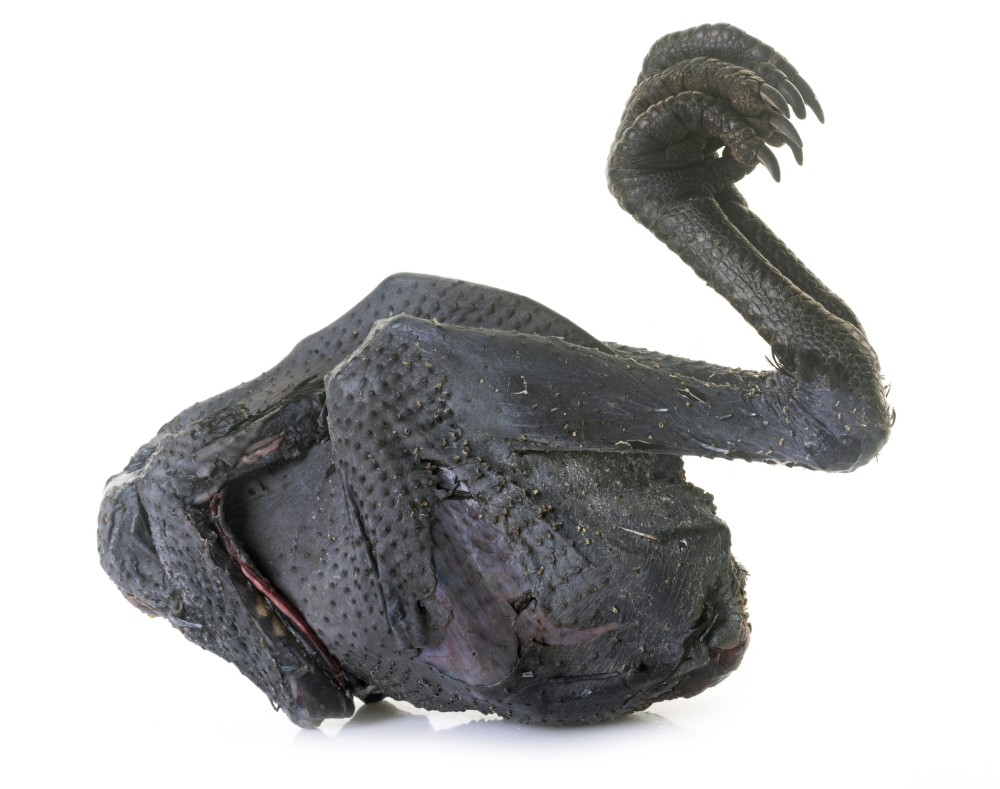One of the blackest animals on Earth is a chicken. In Java, Indonesia, where the bird is native, it’s known as Ayam Cemani. Across the internet, the majestic hyper-melanistic bird is known as the goth chicken.
Black bones, tissue, and organs are rare in the animal kingdom, and the Ayam Cemani chicken is one of only a handful of birds known to have this coloration. It’s a pretty cool look that comes with a curious scientific explanation, caused by a complex rearrangement in these birds’ genome that completes the Ayam Cemani look.
Fibromelanosis: the secret to Ayam Cemani
How did the chicken blacken its clothes? According to a 2017 paper, “The origin and evolution of fibromelanosis in domesticated chickens,” it all comes down to the genes. Both Ayam Cemani and Silkie breed chickens have black tissues beneath their feathers, though in the Silkie, the plumage is famously snow-white.
Pluck away the plume, however, and you have yourself one goth chicken carcass – so what connects these two birds? They both exhibit fibromelanosis, a type of hyperpigmentation that’s turned their tissues black. The driving force behind it appears to be a complex mutation involving the EDN3 gene, which codes for endothelin-3.
Endothelin-3 is pivotal for the pigmentation of birds because it can alter the way melanocytes are distinguished, created, and spread around the body. Dark pigment in tissue comes from melanin, and we see it across the animal kingdom. Ayam Cemani has so much of it because due to a (potentially) thousands-of-years-old mutation, its EDN3 gene is upregulated. This means it’s expressed in pretty much all of the cells in the body, resulting in the development of an embryo that’s chock-full of pigment cells, from its bones to its beak.
The ancient genetic mix-up that underpins fibromelanosis is thought to have happened just once in a single bird that lived hundreds – or possibly thousands – of years ago, geneticist at Uppsala University in Sweden Leif Andersson told National Geographic.
“The mutation underlying fibromelanosis is very peculiar, so we are sure that it occurred once,” he said.

The black bones, tissue, and organs of Ayam Cemani and Silkie chickens track back to a single mutation that occurred in one bird hundreds, if not thousands, of years ago.
Image credit: cynoclub, iStock
Black tissue means black meat, so what’s it like?
Having black bones, organs, and beaks doesn’t appear to impact the chickens in life, but it has flagged them as a food source for humans. The hyper-melanistic meat is considered more valuable than your typical chicken, and may even have health benefits.
“As a kind of folk invigorant and a source of traditional Chinese medicine, [Silkie chickens are] used to reinforce body immunity and protect from emaciation and feebleness,” said co-researcher Ying-gang Tian in a release about the fribomelanistic meat of Silkie chickens. It’s long been believed to be beneficial for diabetes, anemia, menstrual cramps, and postpartum disorders, and Tian and colleagues may have worked out why.
A peptide called Carnosine is used in parts of the world as a dietary supplement for its perceived benefits in increasing muscle strength, promoting healthy aging, and managing diabetes. Poultry is known to be a good source of Carnosine, but the black meat of Silkie chickens was found to boast double the concentration compared to the meat of common White Plymouth Rock chickens.
So, there may be more to the jet-black Ayam Cemani goth chicken than meets the eye.
All “explainer” articles are confirmed by fact checkers to be correct at time of publishing. Text, images, and links may be edited, removed, or added to at a later date to keep information current.
Source Link: Black Bones, Tissue, And Organs: The Curious Case Of The Goth Chicken